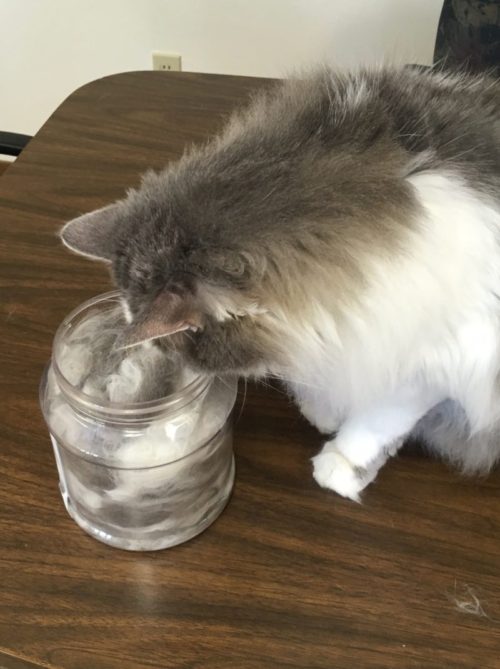Why a Vet?
Why did I become a veterinarian? I cannot tell you how many times I have heard that question. The other common response when someone finds out that I am a veterinarian is “ I considered that profession.” When visiting schools for career days or educational sessions, we often have more interest from students than other professions. What is the attraction? Why is this career so coveted by people around the globe?
I cannot say that I have any simple responses to these questions but wanted to share my story as one example. My farm background certainly contributed to my desire to be a veterinarian. At age 10, I told my parents I wanted to be a veterinarian. That was in 1972, and at that time there were very few women vets. My parents were always supportive, but I cannot say the same for other people in my life. Up to that point I had been caring for baby pigs, baby kittens, and horses. Whenever the vet came to our farm my dad would make a point to let me join them to observe. I was a 4-H and FFA member involved in showing hogs and meat judging during my high school years. I was a County and District Pork Queen and educated people about pork in Iowa and California. I never had the opportunity to work with a veterinarian prior to veterinary school but always knew I wanted to care for animals. I completed my undergraduate college course requirements in three years and applied to the College of Veterinary Medicine in the spring of 1984. I was accepted for the fall of that year and had all intentions of being a large animal veterinarian, since I worked with horses and hogs prior to college and had no fear of cattle or other food producing animals.
What caused the change of heart? Why did I decide to go down the path of small animal medicine instead? Many factors affected this decision. While attending veterinary school, you learn all species so at the completion of your education you can chose a number of different career paths. This leaves one to ponder all the opportunities that present themselves during these four years of veterinary school. Many only think about private practice when considering a career in veterinary medicine. What people do not realize is research, food safety, academia, government, animal welfare, pharmaceuticals and biotechnology, and military positions are other options that can be very rewarding career paths as well.
I recall during my senior year a cold winter night that I was on emergency duty and a male classmate returned from a cattle call. I asked him how it had gone delivering the unborn calf and he remarked, “I was stripped down to my jeans on the cold damp floor of the barn trying to reposition a calf in a cow that would not stand up.” My first thought was, I cannot do that. My second thought was, I hate the cold. That was when I decided I wanted climate controlled facilities to work out of and animals with fur and feathers that were not larger than myself. I also became aware of the physical side of large animal medicine and the challenges that would present themselves daily. I knew that one day I would want to start a family and working long hours would interfere. These are some of the reasons that I chose a small animal focus coming out of veterinary school. Now my kids have often asked why I did not take up zoo medicine or marine medicine since that sounds so much more exciting. I informed them that living in the Midwest the choices for those two areas would be limited. Especially, in regards to marine animals. I cannot think of the last time I saw a shark in Iowa.
In my years of practice I have been an associate, solo practitioner. and a corporate veterinarian. I have worked out of a new small animal hospital, a mobile home, a store front rental space, a PetSmart store, and seasoned mixed animal practice. In each and every one of these spaces I have gained more appreciation for the field of Veterinary Medicine. It is a challenging field because we do treat multiple species, but more important, we have to care for the owners as well. There is a bond that is formed between that animal and its owner. We have to figure out if we are a veterinarian or a pet pediatrician. Is this animal an animal, pet, or fur baby? If someone wants to be a veterinarian because they like animals but not people, they need to rethink their profession or consider something other than private practice. We do spend time with animals, but without our communication skills with their owners, we could not be successful. I have encouraged high school students to come and shadow me when they are considering veterinary medicine as a career choice. I want them to get a view of what a day in the life of a vet can look like. I would have to say that I have encouraged as many as I have discouraged. Many view our day as playtime with puppies and kittens. I want them to see that being peed on, pooped on, snotted on, anal glands expressed on, bled on, and scratched and chewed on are all in a days work. More often than not when I return at the end of the day to my home, I get a favorable response from my dog, but my family says, “you stink.” I enjoy my job and am thankful for each day that is brand new and rewarding. Never will a day be routine or mundane. I want these students to see the pain and suffering of some animals as they come to us needing care. I want them to feel the joy when we are able to cure or fix the problem and return them to their grateful owners. I want them to feel the sadness as we assist owners in their final request with an aged pet that no longer has a will to live. I want them to feel the warmth of a tongue on their faces and the smell of puppy breath when that new owner gets their first pet. I want them to experience the reality that some people do not have the financial resources to fix the problem presented and the difficulty surrounding those moments for us as veterinarians and the pet owners. I want them to realize that Veterinary Medicine is a career full of emotions with successes and failures. We cannot fix everything for everyone or for every animal. We have days where we want to walk away because it is hard to tell someone their pet has passed. We have times when we rack our brains trying to figure out why a pet is not responding to our treatments. We have moments we wish we could forget about having to run a business and just do everything at no cost because of our love for animals. We restrain from tantrums when we have to give the flea speech one more time. Then someone comes and thanks us for our care or compassion or attention to their concerns and we continue on. Never forgetting those moments because if we stop feeling the good and/or the bad our effectiveness is gone. It is a constant balancing act within the walls of a veterinary practice.
So what advice would I give someone that is considering a career in veterinary medicine? Take as many science and math courses as you can during high school. Get involved in FFA or 4-H and learn as much as you can about the different species of animals. Volunteer or work in a veterinary facility or a rescue program to learn how to handle animals. Take classes in speech and communications so you are able to talk with people and make good eye contact. Once in college get involved with organizations that will expand your communication skills. Be attentive to your studies and get high marks. If you can manage to work or volunteer along side your studies and still get high marks that will be favorable when applying for veterinary school and or job hunting after college. Many employers, in numerous professions, are more interested in your people skills, communications skills, and your time management skills than your book smarts.
When applying to the ISU College of Veterinary Medicine the average GPA of those accepted into the program was 3.53. When looking at the financial committement annually for the four years of veterinary school, it currently runs $20,014 for in state tuition and greater than $44,000 for out of state tuition. Last year 63.5% of the class were out of state students and 36.5% were in state. Each class is approximately 148 students and currently 80% are women and 20% men. The average yearly salary in Iowa is $78,040 for all veterinarians. The range is $48,310 – $134,560 annually. A new graduate veterinarian making $48,310 annually calculates out to $23.23/hour. A medical doctor easily earns 2-3 times this amount annually with a similar debt after graduation.
After considering all of these factors about veterinary medicine, if this profession still sounds appealing to you, I encourage you to follow your dream. I am glad that I chose to become a Doctor of Veterinary Medicine 45 years ago. I will be celebrating 30 years as a DVM next year and cannot believe how fast this time has gone. Many things have changed during these years but one thing remains constant, people will always need someone to care for their animals, pets, or fur babies. That is job security and I am grateful to be able to work each day in a profession that helps promote the human-animal bond.


